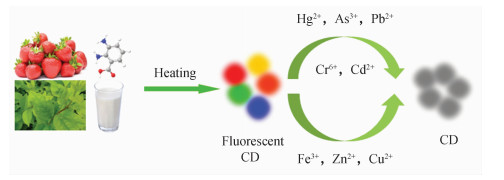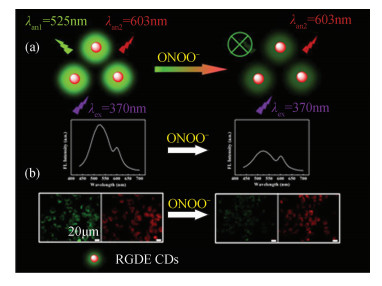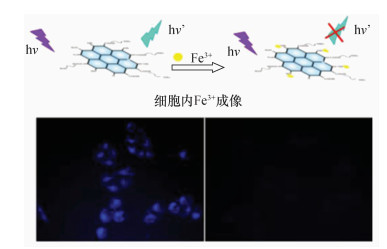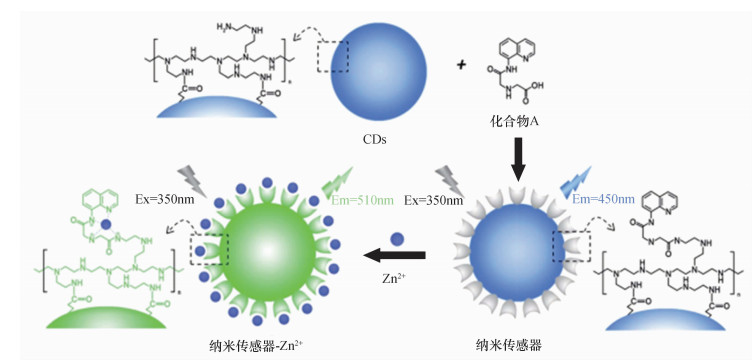A Review of the Preparation of Novel Fluorescent Carbon Dot and Its Application for the Determination of Trace Metal Ions
-
摘要: 碳点(CD)具有粒径小、抗光漂白性好、荧光稳定性高、发射光谱可调、表面易功能化、毒性低及生物相容性好等优点,已在催化、生物成像、药物传递、荧光检测、光电子器件等方面得到了广泛的应用。近年来,利用不同原料制备高性能荧光CD的合成方法备受关注。此外,通过CD直接与目标分析物相互作用,特异性配体修饰后的CD与目标分析物相互作用、CD与其他物质形成复合物后与目标分析物相互作用构建荧光探针,并将其用于微量金属离子的检测得到了迅速发展和广泛应用。本文阐述了CD的光学性质和合成原料,对其常用的自上而下法和自下而上法两类合成方法的过程及特点进行了总结。在此基础上,详细评述了基于CD与目标分析物的三种相互作用方式所构建的荧光探针在测定Fe3+、Zn2+、Cu2+等具有生化作用的离子和Hg2+、As3+、Pb2+、Cr6+、Cd2+等重金属离子的应用进展。本文指出,深入研究检测机理,发展新型检测模式,针对特定金属离子和样品组成设计构建荧光探针,建立可用于复杂样品的分析方法是开展构建新型CD荧光探针所面临的挑战和发展方向。要点
(1) 总结了CD的合成原料、方法及其与目标分析物之间的相互作用方式。
(2) 综述了基于CD构建的荧光探针在测定金属离子中的应用。
(3) 指出构建新型CD荧光探针面临的挑战及发展方向。
HIGHLIGHTS(1) The synthetic raw materials, methods and the interaction modes between CD and target analytes were summarized.
(2) The applications of CD-based fluorescent probes for the determination of metal ions were reviewed.
(3) The challenge and development direction of constructing novel CD-based fluorescent probes were highlighted.
Abstract:BACKGROUNDOwing to their small particle size, good stability against photobleaching, high fluorescence stability, tunable fluorescence emission, easy surface functionalization, low toxicity and excellent biocompatibility, carbon dot (CD) has been widely applied in many fields including catalyst, cell imaging, drug delivery, fluorescence detection and photoelectronic devices. In recent years, synthetic methods for preparing high-performance fluorescent CD using different raw materials have attracted much attention. In addition, detection of trace metal ions by a fluorescent probe has been rapidly developed and widely used. The fluorescent probe can be constructed thus:the CD directly interact with the target analyte, the CD modified by the specific ligand interact with the target analyte, and the CD forming a complex with other substances interact with the target analyte.OBJECTIVESTo provide references for researchers to synthesize CD and construct fluorescent probes based on CD for the determination of trace metal ions in complex samples.METHODSThe optical properties and synthetic raw materials of CD were described. The process and characteristics of the commonly used top-down and bottom-up methods were summarized. The application progress of fluorescent probes constructed by the three interaction modes between CD and target analytes for the determination of biochemical reaction ions, Fe3+, Zn2+ and Cu2+, and other heavy metal ions such as Hg2+, As3+, Pb2+, Cr6+ and Cd2+ were reviewed.RESULTSDifferent raw materials had been utilized for synthesizing CD with different properties. The prepared CD were used to construct fluorescent probes for the determination of micro metal ions with high selectivity and sensitivity.CONCLUSIONSFurther research on the determination mechanisms, development of new detection modes, construction of fluorescent probes for specific metal ions and sample components, and establishment of analytical methods, which can be applied to complex samples are the challenges and development orientation of the fluorescent probes based on CD.
-
Keywords:
- carbon dot /
- fluorescent probe /
- optical properties /
- synthetic materials /
- metal ions
-
荧光分析是一种有效的分析方法,由于其具有灵敏度高、背景噪音低、操作简单等优点,在化学传感、生物成像等领域具有广泛应用[1-4]。近几十年来对荧光探针的研究主要集中在CdSe、CdTe等半导体量子点[5]及传统有机荧光染料[6]的制备及功能化,但是由于制备CdSe、CdTe需引入CdCl2等高毒性的化学物质且耗时较长等问题,传统有机荧光染料的生物毒性较强且其抗光漂白性需进一步改善等问题,限制了半导体量子点和有机荧光染料在荧光分析方法中的广泛应用[7]。因此,寻找理想的、有望替代半导体量子点和有机荧光染料的无毒或低毒的新型荧光纳米材料并将其应用于构建新型荧光探针,已逐渐成为化学、工程和生物医学等各个领域的研究热点。
碳是一种以多种形式广泛存在于大气和地壳中的常见元素之一,它不仅对所有生命系统都是不可或缺的,而且在纳米材料的发展进程中起着至关重要的作用[8-9]。近年来,碳纳米材料作为新型的荧光纳米材料之一,日益成为人们关注的对象。碳纳米材料拥有众多的家族成员,如富勒烯、碳纳米管、石墨烯、碳点、纳米金刚石、碳纳米洋葱及碳纳米角等[10-11]。其中,富勒烯是1985年由Kroto等[12]发现并报道的。碳纳米管和石墨烯这两种同素异形体分别是在1991年和2004年被发现并报道的,当时在科学研究领域引起了极大的轰动[13-14]。在碳纳米材料庞大的家族里,碳点(CD)由于具有粒径小、抗光漂白性好、荧光稳定性高、发射光谱可调、表面易功能化、毒性低、生物相容性好、制备过程简单等优点,在催化、生物成像、药物传递、荧光传感、光电子器件等方面拥有广阔的应用前景而备受关注[15-19]。应指出的是,在荧光传感领域碳点可直接或间接地构建新型的荧光探针并用于测定一些重要的金属离子、非金属离子、小分子及大分子物质等。本文在对CD的性质、合成原料及合成方法简要介绍的基础上,详细评述了基于CD荧光探针的设计、构建机理及其在检测微量金属离子中的应用,指出了CD作为新型荧光传感纳米材料所面临的挑战和发展方向。
1. 碳点的性质、合成原料及合成方法
2004年,Xu等[20]在纯化单壁碳纳米管时发现并报道了CD。2006年,Sun等[21]提出了CD的概念。CD是具有无定型到纳米晶结构的准球形、尺寸不大于10nm的纳米颗粒,一般由sp2/sp3碳、含氧/氮的官能团和一些后修饰的特定官能团组成[3]。研究表明,CD具有包括紫外可见吸收[22-23]、荧光[8]、上转换荧光[24]和电化学发光[25-26]等在内的诸多优异的光学性质。迄今为止,众多课题组对CD合成和应用作了许多深入的研究,旨在更好地探究其复杂的光物理和光化学行为的起源,以开发更好的合成方法并进一步拓展其应用范围。
1.1 合成CD的原料
合成CD的原料非常丰富,包括一些较大的碳骨架材料、小分子化学物质、食品、日用品、生活废弃物及植物器官等。
1.1.1 碳骨架材料
Scrivens等在应用电泳方法纯化单壁碳纳米管的过程中发现并报道了CD[20]。Liu等[27]以蜡烛烟灰为原料,通过酸氧化处理的方法制备了尺寸小于2nm的水溶性多色荧光CD,并采用聚丙烯酰氨凝胶电泳对其进行纯化,得到了具有不同荧光发射的CD,它们的量子产率分别为0.8%、1.9%、0.8%。
Qiao等[28]以活性炭为碳源,通过化学氧化方法制备了尺寸约为4.5nm的水溶性多色荧光CD。该CD在pH 1~13范围内均具有良好的生物相容性和较高的荧光量子产率(12.6%)。
1.1.2 小分子化学物质
CD的合成原料除了较大的碳骨架材料之外,一些小分子物质如柠檬酸经常被用作碳源来合成具有高荧光量子产率的CD,但是这些CD一般呈现出蓝色荧光。Zhu等[29]以柠檬酸为碳源通过水热法制备了荧光量子产率高达80%的蓝色荧光CD,其不仅能够检测生物体系中的Fe3+,还可用作印刷油墨。Krysmann等[30]通过热解柠檬酸和乙醇胺制备了荧光量子产率为50%的蓝色荧光CD,并对其可能的发光机理进行了探究。Dong等[31]用柠檬酸和半胱氨酸通过水热法制备了荧光量子产率高达73%的CD,该CD呈现出蓝色荧光且具有不依赖激发的发射行为。
1.1.3 食品、日用品及生活废弃物
合成CD的原料丰富多彩。目前,许多课题组已经报道了采用常见的食品(草莓、蜂蜜、牛奶、生姜),日用品(蚕丝)及生活中的废弃物(纸灰、废煎炸油)制备出荧光CD的工作[32-38]。Wang等[34]报道了使用牛奶制备CD的绿色合成方法。该制备过程环保、简单、高效。所制备的蓝色荧光碳点,尺寸约为3nm、荧光量子产率为12%,可作为荧光探针对人脑胶质瘤癌细胞进行高分辨成像。Hu等[38]发展了一种利用废煎炸油和浓硫酸制备蓝色荧光CD的方法,所得到的CD尺寸均匀并显示出部分无序的石墨结构且对pH变化非常敏感,可用于测定pH值。
1.1.4 植物器官
Zhu等[39]发现热解不同的植物叶片可得到发出明亮蓝色荧光的CD,其可用于化学传感、图案印刷及防伪技术等。该制备方法无需表面钝化处理或使用有毒及昂贵的溶剂和原料,为大规模生产CD提供了新的契机。
1.1.5 含苯环结构的化合物
采用上述几类原料合成的CD多具有蓝色荧光。由于生物样品的自荧光干扰较大,从而限制了其在生物样品分析和生物成像研究中的应用。相比之下,发射红光的CD可以有效解决生物样品的自荧光干扰问题。增加共轭程度可能会使得CD的荧光发射波长红移,因此选择含有苯环结构的碳源可能会有效改善CD的荧光性质。Jiang等[40]以邻、间、对苯二胺为碳源,分别得到了具有上述转换荧光性质的蓝色、绿色及红色荧光CD,其细胞毒性低,具有优异的多色细胞成像能力。Liu等[41]用2, 5-二氨基苯磺酸和4-氨基苯硼酸盐酸盐合成了荧光量子产率为5.44%的红色荧光CD,其可用于比色和荧光双模式检测Fe3+。
Ma等[42]以间氨基苯酚和草酸为原料制备了蓝/绿光双发射的CD。当激发波长为380nm时,所制备的CD在430nm和510nm处具有双荧光发射峰。首先,对氨基苯酚和草酸小分子脱水形成了聚合物簇。随着反应温度的进一步升高,聚合物簇逐渐被碳化最终生成了小颗粒状蓝/绿光双发射的CD。该CD无需修饰可直接作为比率荧光探针检测纺织品、钢铁样品和工业废水中的六价铬离子。
Liu等[43]以2, 5-二氨基甲苯硫酸盐为碳源一锅法制备了红/绿光双发射的CD(RGDE CD)。当激发波长为370nm时,RGDE CD在525nm和603nm处具有两个荧光发射峰(图 1)。基于RGDE CD无需任何修饰即可作为ONOO-荧光探针的性质,建立了成本低廉、响应速度快、灵敏度高、选择性好的测定ONOO-的比率荧光新方法。通过分别计算RGDE CD和ONOO-对应的HOMO、LUMO能级,深入研究了ONOO-导致RGDE CD荧光淬灭的机理。该比率荧光探针已成功用于细胞内痕量ONOO-的测定。
此外,Liu等[44]还以2, 3-二氨基苯甲酸盐酸盐为碳源一锅法合成了红/黄光双发射的碳点(RYDE CD)和红/橙光双发射的碳点(RODE CD)(图 2)。当激发波长分别为520nm和535nm时,RYDE CD和RODE CD分别在566nm/621nm和595nm/644nm处具有荧光发射峰。所制备的RYDE CD和RODE CD具有优异的抗光漂白性和良好的耐盐性。基于RYDE CD无需修饰可直接作为亚硝酸盐荧光探针的性质,建立了高灵敏性和高选择性测定熏肉、香肠、咸菜和牛奶等样品中痕量亚硝酸盐的比率荧光新方法并深入研究了相应的检测机理;基于温度对RYDE CD荧光强度的影响,建立了检测温度的比率荧光新方法。此外,RYDE CD细胞毒性低且生物相容性好,可成功用于细胞成像。
1.2 CD的合成方法
在过去几十年中,人们不断地尝试发展了许多合成CD的方法。根据合成原料(1.1节)可将CD的合成方法分为自上而下法和自下而上法两大类[45]。
自上而下法是指将较大的碳骨架材料如碳纳米管[20]、活性炭[28]、炭黑[27]、纳米金刚石[46]等通过化学或物理的方法不断进行剥离制备CD的过程。常见的自上而下法主要包括电弧放电法[47]、激光烧蚀法[21]和电化学法[48]等。自上而下法制备的CD的荧光量子产率比较低,通常需要将其表面进行化学处理以提高荧光量子产率。此外,由于剥离的过程是非选择性的,不能有效地控制CD的形态和粒径分布。
为了克服自上而下法合成CD的荧光量子产率较低等问题,人们发展了在适当条件下依赖于有机小分子碳源碳化或者逐步熔融的方式制备CD的化学方法,即自下而上法。自下而上法可以较好地控制CD的尺寸、形貌及物理化学性质。目前,自下而上法主要包括水热法[29]、模板辅助法[49]、微波法[50]和超声辅助法[51]等。这些方法所合成的CD在荧光探针构建、目标分析物检测、生物成像等方面均有广泛的应用[52-54]。
2. 基于CD荧光探针的设计构建及其在检测金属离子中的应用
2.1 基于CD荧光探针的设计构建及其对金属离子的检测机理
由于CD具有优异的光学性质以及较低的细胞毒性和良好的生物相容性[55],常被用于直接或间接地设计构建新型的荧光探针来检测金属离子等目标分析物[56-57]。实际样品中通常存在多种金属离子。因此,CD荧光探针对金属离子的特异性识别对探针的设计及测定结果的准确性至关重要。通常,根据CD表面官能团和金属离子的特点及它们之间的特异性作用来提高检测的选择性。迄今为止,设计构建对金属离子具有特异性识别能力的CD荧光探针主要基于以下三种策略[3]:①基于CD表面的官能团直接特异性识别金属离子;②通过特异性配体对CD进行修饰以提高其对金属离子的特异性识别能力;③将CD与其他物质如淬灭剂结合形成复合物以提高其对金属离子的特异性识别能力。目前,CD荧光探针对金属离子的检测主要有“Turn-off”[58]和“Turn-on”[59]两种模式。这两种模式所涉及的检测机理主要包括电子转移[60]、内过滤效应[61]、荧光共振能量转移[59, 62]等。
2.1.1 基于CD与目标分析物的直接相互作用
CD与目标分析物直接相互作用会引起CD的荧光信号发生变化。基于这种信号的变化,CD可直接作为荧光探针用于测定目标分析物的含量。CD表面的官能团可以特异性地与金属离子发生配位作用,使得其荧光发生显著的淬灭,因此常被用于直接测定一些金属离子的含量。例如,由于氢氧化铁的Ksp=4.0×10-38,导致Fe3+和酚羟基之间会发生强烈的特异性配位作用,因此表面富含酚羟基的CD可以实现对Fe3+的选择性检测[3]。Zhu等[29]合成了荧光量子产率高达80%的CD,其表面的酚羟基与Fe3+之间有很强的亲和力。当加入Fe3+后,CD激发态的电子会部分跃迁到Fe3+的d轨道,发生非辐射电子跃迁,导致CD的荧光淬灭。基于此,该CD可直接作为荧光探针选择性检测Fe3+。此外,CD表面富含的大量氨基和Cu2+之间会发生强烈的配位作用,形成的铜胺络合物紫外吸收光谱可以与部分CD的荧光激发或发射光谱重叠,发生内过滤效应导致CD的荧光淬灭。Dong等[61]制备了能与Cu2+发生络合作用的表面富含氨基的CD,形成的铜胺络合物和CD之间的内过滤效应使得CD荧光淬灭,从而实现了CD直接作为荧光探针对Cu2+进行选择性检测。
2.1.2 基于特异性配体修饰后的CD与目标分析物相互作用
将CD进行后修饰再与分析物相互作用也是一种策略。一般需要将已知的特异性配体修饰到CD表面以构建具有高灵敏度和高选择性的荧光探针。例如,将硼酸基团修饰到CD表面后,硼酸基团和葡萄糖的顺式二醇结构会形成稳定的络合物[63]。基于此,构建了很多用于高选择性检测葡萄糖的荧光探针。此外,胸腺嘧啶(T)化学结构简单,已被证明是能够以T-Hg2+-T复合物形式识别Hg2+的最具特异性的配体之一,该过程不存在任何其他重金属离子的干扰[64]。因此,可以通过将CD和某些生物识别组件(如胸腺嘧啶等)结合提高CD检测Hg2+的选择性。Xu等[64]基于Hg2+可作为有效联接邻近胸腺嘧啶的桥梁,利用CD表面上共价修饰胸腺嘧啶和Hg2+的桥梁作用促使CD团聚,导致CD荧光发生淬灭,设计并构建了用于特异性检测Hg2+的荧光探针。
2.1.3 基于CD与其他物质形成复合物后与目标分析物相互作用
CD也可以与其他物质如淬灭剂[65]等结合形成复合物使得其荧光发生淬灭,加入目标检测物之后,淬灭剂和目标检测物之间发生相互作用导致CD的荧光得以恢复。例如,Li等[59]将CD和钴氢氧化物纳米片结合,使得其荧光通过荧光共振能量转移发生淬灭。然后加入还原性的抗坏血酸,由于抗坏血酸和钴氢氧化物纳米片发生了氧化还原反应,从而破坏了钴氢氧化物纳米片的片层结构,使得CD的荧光恢复。基于这种荧光响应信号,实现了对抗坏血酸及与抗坏血酸有关的酶的检测。此外,将CD和其他荧光物质结合还可以构建比率荧光探针。如Liang等[62]基于CD和金纳米簇(AuNCs)间的荧光共振能量转移成功构建了比率荧光探针(图 3)。加入的S2-会竞争性地结合在AuNCs表面形成Au2S,抑制荧光共振能量转移的发生,使得CD的荧光增强而AuNCs的荧光减弱。基于CD和AuNCs荧光强度比值的变化,实现了对环境样品中S2-的准确测定。
2.2 CD荧光探针在检测金属离子中的应用
由于CD具有独特的结构和优异的光学性能,已在生物成像、荧光传感、药物运载、催化剂制备、能源开发等领域应用前景广阔[66-69]。
近年来,全球经济和工业化的快速增长引起了越来越多的环境问题。重金属离子是一种易在生态系统中富集的难降解污染物[70]。根据美国环境保护署(EPA)的统计,砷离子(As3+)、汞离子(Hg2+)、铅离子(Pb2+)、铜离子(Cu2+)、镉离子(Cd2+)、镍离子(Ni2+)和铬离子(Cr6+)属于最具毒性的重金属离子。人体内摄入低浓度的这些金属离子时,可导致极其严重的健康问题[71]。例如铁离子(Fe3+)、锌离子(Zn2+)和铜离子(Cu2+)等会参与人体新陈代谢过程,对人类健康至关重要。但是,当这些金属离子的浓度较高时,它们会破坏人体免疫系统,诱发一系列严重的疾病[72-73]。因此,快速、灵敏、准确地测定微量金属离子在环境保护、食品科学和农业化学以及材料学等领域具有重要意义。传统的检测痕量金属离子的方法[74-78]有原子吸收光谱法(AAS)、毛细管电泳法(CE)、电感耦合等离子体发射光谱法(ICP-OES)、离子色谱-紫外可见光谱法(IC-UV-Vis)、电感耦合等离子体质谱法(ICP-MS)、微探针法(MP)和X射线荧光光谱法(XRF)。这些方法虽然具有高灵敏度和选择性,但仪器成本高、样品制备复杂以及需要专业人员和预富集程序等操作。荧光分析是一种有效的分析方法,由于其具有灵敏度高、背景噪音低、操作简单等优点而备受人们的关注。下面对CD在荧光传感领域中检测金属离子的应用进展进行评述。
2.2.1 CD荧光探针检测生物金属离子
(1) 铁离子(Fe3+)
铁是人体和动物体许多生理过程所必需的第一微量元素。Fe3+可以和人体内多种调节蛋白质结合,在新陈代谢过程中扮演非常重要的角色。人体内Fe3+含量异常均可干扰细胞内环境平衡,诱发各种生理疾病[79-80]。因此,对Fe3+的高灵敏检测具有重要意义。目前,基于金属纳米簇[81]、有机染料[82]、半导体量子点[83]、金属有机框架材料[84]等已经发展了诸多荧光探针,这些探针用于检测Fe3+通常具有较好的灵敏度和选择性。然而,制备这些荧光探针通常需要多步骤合成及纯化步骤,比较耗时。CD已被证明其合成原料低廉、制备过程简单、细胞毒性低、生物相容性好,是一种理想的可用于构建荧光探针的新型荧光纳米材料。
Zhang等[60]以柠檬酸为碳源、聚乙烯二胺为氮源,通过固相合成法制备了氮掺杂CD(N-CD)。结果表明,N原子的掺杂使得CD的荧光量子产率从9%提高到31%,荧光量子产率的显著提高应该源于N原子对CD化学结构和电子特性的调控。基于N-CD表面的含氧官能团与Fe3+之间的配位作用使其荧光淬灭的现象,实现了对生物样品中Fe3+的测定(图 4)。
Feng等[85]以胰蛋白酶和多巴胺为前驱体,通过一步法在低温条件下制备了荧光CD。该步骤避免了任何加热操作和使用有机试剂,提供了一种“绿色”、有效的合成策略。制备的CD具有良好的水溶性、耐盐性和光稳定性。基于内滤效应和静态淬灭的协同作用,实现了尿液和血清样品中Fe3+的测定。
(2) 锌离子(Zn2+)
锌是人体中最常见的第二微量过渡金属元素,在促进酶调节、基因表达和神经相关信号传递等过程中发挥重要作用。人体内Zn2+含量异常会诱发阿尔茨海默症等疾病[86]。因此,对Zn2+的高灵敏检测对于探究某些疾病的生理过程和病因具有重要意义。目前已报道的测定Zn2+的方法有荧光分析法[87]、毛细管电泳法[88]和紫外可见吸收光谱法[89]等。尤其是荧光分析法具有灵敏度高、背景噪音低、操作简单等优点。因此,发展基于低毒性CD荧光探针的荧光分析新方法用于灵敏性、选择性检测细胞内Zn2 +非常重要。
Zhang等[90]合成了喹啉衍生物修饰的CD,基于喹啉衍生物对Zn2+的特异性识别作用使得CD荧光增强的现象,建立了高灵敏、高选择性检测Zn2+的荧光方法,检测限为6.4nmol/L(图 5)。该方法还可以实现细胞内Zn2+的实时成像。
(3) 铜离子(Cu2+)
铜是人们日常生活中必不可少的过渡金属元素,常存在于海水、河水、湖水、饮用水和自来水中。Cu2+的存在对生物系统的正常免疫代谢过程起着至关重要的作用。然而,浓度较高的Cu2+长期与人体接触,会产生较大的毒性,引起许多神经退化性疾病,如威尔逊氏病、朊病毒病和阿尔茨海默症等[91-92]。因此,对Cu2+的高灵敏检测也十分重要。迄今为止,作为测定Cu2+的探针主要包括半导体量子点、有机染料和小分子荧光探针[93-95]。但是,这些荧光探针存在制备过程中需使用高毒性的化学物质,或合成过程复杂、抗光漂白能力较差等问题。CD作为一种新型的荧光纳米材料,以其构建的荧光探针可有效避免上述问题。
Gedda等[96]以对虾壳为原料,发展了一种简便、经济、有效地合成绿色荧光CD的方法。所制备的CD分散性高、稳定性好、水溶性好,量子产率为9%。基于Cu2+和CD之间内过滤效应和胺铜的形成使得CD荧光淬灭的现象,建立了高灵敏、高选择性检测Cu2+的荧光新方法,检测限为5nmol/L。该方法可用于饮用水、河水、海水等多种样品中Cu2+的快速测定。
2.2.2 CD荧光探针检测其他重金属离子
通常,检测重金属离子的传统方法如电感耦合等离子体质谱、原子吸收/发射光谱法等通常需要昂贵的仪器设备及复杂的操作程序[97-101],从而限制了这些方法对Hg2+、As3+、Pb2+、Cr6+、Cd2+等重金属离子的实时检测,而基于CD荧光探针建立的荧光分析方法具有快速、简便、灵敏度高、选择性好等诸多优点,对于建立选择性好、灵敏度高的检测以上微量重金属离子的方法具有实际意义。
(1) 汞离子(Hg2+)
Hg2+是一种最危险的、广泛存在的污染物之一,已引发了严重的环境和健康问题[102-103]。研究表明Hg2+很容易通过皮肤、呼吸道和消化道组织导致DNA损伤、细胞分裂障碍和中枢神经系统的永久性损害[104]。因此,发展选择性好、灵敏度高的检测微量Hg2+的方法十分重要。
Liu等[105]以柠檬酸和(NH4)3PO4分别作为碳源和氮源,通过固相合成法简单、快速地制备了荧光量子产率高达36%的氮掺杂CD(N-CD)。基于N-CD表面的类吡咯N、N-H和Hg2+之间的协同配位作用导致其荧光淬灭的现象,建立了一种简单、快速地测定食品和化妆品等样品中Hg2+含量的荧光新方法。该N-CD具有低细胞毒性和良好的生物相容性,可成功用于细胞成像。基于N-CD的良好水溶性,还可作为荧光墨水使用。
Lu等[106]以柚子皮为原料,通过水热法制备了水溶性的CD,荧光量子产率为6.9%。该CD可直接作为荧光探针对Hg2+进行选择性检测,检测限低至0.23nmol/L。Hg2+对CD的荧光淬灭可能是通过有效的电子或能量转移过程促进了无辐射的电子/空穴复合湮灭。
(2) 砷离子(As3+)
饮用水中的砷污染在发展中国家是一个非常严重的问题[107]。在砷元素的各种形式中,As3+被认为是最有害的污染物。根据世界卫生组织的标准,饮用水中As3+的最大允许量为10μg/L(133nmol/L)。如果人体中As3+的持续摄入量超过10μg/L,会诱发皮肤损伤、免疫及代谢系统紊乱、高危肺癌和膀胱癌等,严重威胁人类健康[99]。
Gupta等[99]以柠檬酸和硫代硫酸钠为原料,采用微波辅助热解法合成了硫掺杂的多色荧光CD。所制备的CD经GSH修饰后与As3+之间发生相互作用形成复合物导致其荧光发生淬灭。基于上述现象建立了高灵敏性、高选择性检测As3+的荧光及可视化新方法,检测限为32pmol/L。此外,应用该方法成功实现了河水和自来水中As3+的准确测定。
(3) 铅离子(Pb2+)
Pb2+被广泛应用于颜料、水管、蓄电池、防腐涂料、合金中,并以不同的方式释放于环境中。据报道,当血液中Pb2+浓度高于5μmol/L时,可导致贫血、生殖功能障碍、神经系统功能障碍、发育障碍等疾病。此外,Pb2+浓度过高甚至会导致死亡[97, 108]。
Liu等[97]以柠檬酸钠和聚丙烯酰胺为原料,通过水热法合成了蓝色荧光CD。Pb2+和CD形成CD-Pb2+复合物使得CD的荧光淬灭,再加入能与Pb2+络合的PPi可使CD荧光得以恢复。基于此现象建立了检测Pb2+和PPi的荧光新方法,检测限分别为4.6nmol/L、54nmol/L。
(4) 铬离子(Cr6+)
Cr6+在电镀、皮革鞣制、染料等工业生产中有着广泛的应用。但是,Cr6+具有致突变性和致癌性,严重威胁人类的身体健康[109]。
Ma等[42]以间氨基苯酚和草酸为原料制备了蓝/绿光双发射的CD。当激发波长为380nm时,所制备的CD在430nm和510nm处具有两个荧光发射峰。该CD无需修饰可直接作为比率荧光探针对纺织品、钢铁样品和工业废水中的Cr6+含量进行测定。
Mutuyimana等[110]以4-氨基乙酰苯胺盐酸盐和4-乙酰氨基苯甲醛为原料,通过一步法合成了黄色荧光CD。所制备的CD具有良好的水溶性、耐盐性和荧光稳定性。基于Cr6+和CD之间发生静态淬灭作用使得CD荧光被淬灭的现象,建立了测定Cr6+的荧光新方法,检测限为0.13μmol/L。该方法灵敏度高、选择性好,已成功应用于鱼肉和小虾米中Cr6+的测定,回收率结果良好。
(5) 镉离子(Cd2+)
镉元素广泛存在于塑料、化肥、农药和化石燃料中。土壤、水和食物中的Cd2+污染通过食物链对人类身体健康构成了潜在的致命威胁[111-112],可导致骨质疏松症、肾功能障碍、癌症、阿尔茨海默病、帕金森病和肌萎缩侧索硬化症等神经退行性疾病。
Niu等[101]将CD和金纳米团簇(AuNCs)相结合构建了CD-AuNCs比率荧光探针。基于AuNCs表面官能团和Cd2+之间的静电吸附和配位作用导致其荧光淬灭的现象,建立了测定Cd2+的比率荧光新方法,检测限为32.5nmol/L。
3. 发展问题与展望
全球经济和工业化的快速发展加剧了重金属污染物向自然环境中的排放,对人类和生态系统构成了严重威胁,高毒性且易在生态系统中富集的难降解金属污染物对自然环境和人体健康造成的影响更为严重。为了改善人类的生存质量,急需发展高灵敏度、高选择性、环境友好的测定方法。由于CD具有荧光稳定性高、表面易功能化、毒性低等优点,已成为发展高灵敏度、高选择性的测定微量金属离子的一种优异的新型荧光探针并得到了较为广泛的应用。
本文认为,为了使CD荧光探针能更好地满足检测微量金属离子的要求,今后应重点围绕以下四个方面开展研究工作:①深入研究相应的检测机理,为新型荧光探针的设计构建提供坚实的理论指导;②发展新的检测模式以拓宽CD荧光探针的应用范围;③针对待测的微量金属离子的性质和样品基质,设计合成新型CD荧光探针;④建立可用于复杂基质样品的荧光新方法,为复杂样品特别是生物样品中微量金属离子的测定提供强有力的技术支持。
-
-
Xu X, He L, Long Y W, et al.S-doped carbon dots capped ZnCdTe quantum dots for ratiometric fluorescence sensing of guanine[J]. Sensors and Actuators B:Chemical, 2019, 279:44-52. doi: 10.1016/j.snb.2018.09.102
李庆霞, 刘亚轩, 陈卫明, 等.荧光光谱法分析油气化探样品中的芳烃[J].岩矿测试, 2014, 33(4):561-569. doi: 10.3969/j.issn.0254-5357.2014.04.018 Li Q X, Liu Y X, Chen W M, et al.Analysis of aromatic hydrocarbons in oil and gas geochemical exploration samples by fluorescence spectrometry[J]. Rock and Mineral Analysis, 2014, 33(4):561-569. doi: 10.3969/j.issn.0254-5357.2014.04.018
Sun X C, Lei Y.Fluorescent carbon dots and their sensing applications[J]. TrAC Trends in Analytical Chemistry, 2017, 89:163-180. doi: 10.1016/j.trac.2017.02.001
许金钩.荧光分析法近年来的某些进展[J].岩矿测试, 1992, 11(1):53-57. http://www.ykcs.ac.cn/article/id/ykcs_19920108 Xu J G.Some recent advances in fluorimetry[J]. Rock and Mineral Analysis, 1992, 11(1):53-57. http://www.ykcs.ac.cn/article/id/ykcs_19920108
Prapainop K, Mekseriwattana W, Siangproh W, et al.Successive detection of benzoic acid and total parabens in foodstuffs using mercaptosuccinic acid capped cadmium telluride quantum dots[J]. Food Control, 2019, 96:508-516. doi: 10.1016/j.foodcont.2018.10.009
Huo F J, Su J, Sun Y Q, et al.A rhodamine-based dual chemosensor for the visual detection of copper and the ratiometric fluorescent detection of vanadium[J]. Dyes and Pigments, 2010, 86(1):50-55. doi: 10.1016/j.dyepig.2009.11.007
Liu J J, Chen Y L, Wang W F, et al."Switch-on" fluorescent sensing of ascorbic acid in food samples based on carbon quantum dots-MnO2 probe[J]. Journal of Agricultural and Food Chemistry, 2015, 64(1):371-380. http://www.wanfangdata.com.cn/details/detail.do?_type=perio&id=26ab717c7faaa55438d2ef48b5c05d2a
Peng Z L, Han X, Li S H, et al.Carbon dots:Bioma-cromolecule interaction, bioimaging and nanomedicine[J]. Coordination Chemistry Reviews, 2017, 343:256-277. doi: 10.1016/j.ccr.2017.06.001
Shah S N A, Lin J M.Recent advances in chemilumin-escence based on carbonaceous dots[J]. Advances in Colloid and Interface Science, 2017, 241:24-36. doi: 10.1016/j.cis.2017.01.003
Hong G S, Diao S, Antaris A L, et al.Carbon nanoma-terials for biological imaging and nanomedicinal therapy[J]. Chemical Reviews, 2015, 115(19):10816-10906. doi: 10.1021/acs.chemrev.5b00008
Bartelmess J, Quinn S J, Giordani S.Carbon nanoma-terials:Multi-functional agents for biomedical fluorescence and Raman imaging[J]. Chemical Society Reviews, 2015, 44(14):4672-4698. doi: 10.1039/C4CS00306C
Kroto H W, Heath J R, O'Brien S C.C60:Buckmin-sterfullerene[J]. Nature, 1985, 318(6042):162-163. doi: 10.1038/318162a0
Iijima S.Helical microtubules of graphitic carbon[J]. Nature, 1991, 354(6348):56-58. doi: 10.1038/354056a0
Novoselov K S, Geim A K, Morozov S V, et al.Electric field effect in atomically thin carbon films[J]. Science, 2004, 306(5696):666-669. doi: 10.1126/science.1102896
Jiang J J, Ye G, Wang Z, et al.Heteroatom-doped carbon dots (CDs) as a class of metal-free photocatalysts for PET-RAFT polymerization under visible light and sunlight[J]. Angewandte Chemie International Edition, 2018, 57(37):12037-12042. doi: 10.1002/anie.201807385
Li F, Li T Y, Sun C X, et al.Selenium-doped carbon quantum dots for free-radical scavenging[J]. Angewandte Chemie International Edition, 2017, 56(33):9910-9914. doi: 10.1002/anie.201705989
Gong P W, Sun L, Wang F, et al.Highly fluorescent N-doped carbon dots with two-photon emission for ultrasensitive detection of tumor marker and visual monitor anticancer drug loading and delivery[J]. Chemical Engineering Journal, 2019, 356:994-1002. doi: 10.1016/j.cej.2018.09.100
Moniruzzaman M, Kim J S.Mechanistic studies on the β-resorcylic acid mediated carbon dots for the pH-induced fluorescence switch and sensing application[J]. Dyes and Pigments, 2019, 163:538-546. doi: 10.1016/j.dyepig.2018.12.041
Qu S N, Wang X Y, Lu Q P, et al.A biocompatible fluorescent ink based on water-soluble luminescent carbon nanodots[J]. Angewandte Chemie International Edition, 2012, 51(49):12215-12218. doi: 10.1002/anie.201206791
Xu X Y, Ray R, Gu Y L, et al.Electrophoretic analysis and purification of fluorescent single-walled carbon nanotube fragments[J]. Journal of the American Chemical Society, 2004, 126(40):12736-12737. doi: 10.1021/ja040082h
Sun Y P, Zhou B, Lin Y, et al.Quantum-sized carbon dots for bright and colorful photoluminescence[J]. Journal of the American Chemical Society, 2006, 128(24):7756-7757. doi: 10.1021/ja062677d
Zheng M, Xie Z G, Qu D, et al.On-off-on fluorescent carbon dot nanosensor for recognition of chromium(Ⅵ) and ascorbic acid based on the inner filter effect[J]. Applied Materials & Interfaces, 2013, 5(24):13242-13247.
Baker S N, Baker G A.Luminescent carbon nanodots:Emergent nanolights[J]. Angewandte Chemie International Edition, 2010, 49(38):6726-6744. doi: 10.1002/anie.200906623
Goryacheva I Y, Sapelkin A V, Sukhorukov G B.Carbon nanodots:Mechanisms of photoluminescence and principles of application[J]. TrAC Trends in Analytical Chemistry, 2017, 90:27-37. doi: 10.1016/j.trac.2017.02.012
Zheng L Y, Chi Y W, Dong Y Q, et al.Electrochemi-luminescence of water-soluble carbon nanocrystals released electrochemically from graphite[J]. Journal of the American Chemical Society, 2009, 131(13):4564-4565. doi: 10.1021/ja809073f
Zhang P J, Xue Z J, Luo D, et al.Dual-peak electro-generated chemiluminescence of carbon dots for iron ions detection[J]. Analytical Chemistry, 2014, 86(12):5620-5623. doi: 10.1021/ac5011734
Liu H P, Ye T, Mao C D.Fluorescent carbon nano-particles derived from candle soot[J]. Angewandte Chemie International Edition, 2007, 46(34):6473-6475. doi: 10.1002/anie.200701271
Qiao Z A, Wang Y F, Gao Y, et al.Commercially activated carbon as the source for producing multicolor photoluminescent carbon dots by chemical oxidation[J]. Chemical Communications, 2010, 46(46):8812-8814. doi: 10.1039/c0cc02724c
Zhu S J, Meng Q N, Wang L, et al.Highly photo-luminescent carbon dots for multicolor patterning, sensors, and bioimaging[J]. Angewandte Chemie International Edition, 2013, 52(14):3953-3957. doi: 10.1002/anie.201300519
Krysmann M J, Kelarakis A, Dallas P, et al.Formation mechanism of carbogenic nanoparticles with dual photoluminescence emission[J]. Journal of the American Chemical Society, 2012, 134(2):747-750. doi: 10.1021/ja204661r
Dong Y Q, Pang H C, Yang H B, et al.Carbon-based dots Co-doped with nitrogen and sulfur for high quantum yield and excitation-independent emission[J]. Angewandte Chemie International Edition, 2013, 52(30):7800-7804. doi: 10.1002/anie.201301114
Huang H, Lü J J, Zhou D L, et al.One-pot green synthesis of nitrogen-doped carbon nanoparticles as fluorescent probes for mercury ions[J]. RSC Advances, 2013, 3(44):21691-21696. doi: 10.1039/c3ra43452d
Yang X M, Zhuo Y, Zhu S S, et al.Novel and green synthesis of high-fluorescent carbon dots originated from honey for sensing and imaging[J]. Biosensors and Bioelectronics, 2014, 60:292-298. doi: 10.1016/j.bios.2014.04.046
Wang L, Zhou H S.Green synthesis of luminescent nitrogen-doped carbon dots from milk and its imaging application[J]. Analytical Chemistry, 2014, 86(18):8902-8905. doi: 10.1021/ac502646x
Li C L, Ou C M, Huang C C, et al.Carbon dots prepared from ginger exhibiting efficient inhibition of human hepatocellular carcinoma cells[J]. Journal of Materials Chemistry B, 2014, 2(28):4564-4571. doi: 10.1039/c4tb00216d
Wu Z L, Zhang P, Gao M X, et al.One-pot hydro-thermal synthesis of highly luminescent nitrogen-doped amphoteric carbon dots for bioimaging from Bombyx mori silk-natural proteins[J]. Journal of Materials Chemistry B, 2013, 1(22):2868-2873. doi: 10.1039/c3tb20418a
Wei J M, Shen J M, Zhang X, et al.Simple one-step synthesis of water-soluble fluorescent carbon dots derived from paper ash[J]. RSC Advances, 2013, 3(32):13119-13122. doi: 10.1039/c3ra41751d
Hu Y P, Yang J, Tian J W, et al.Waste frying oil as a precursor for one-step synthesis of sulfur-doped carbon dots with pH-sensitive photoluminescence[J]. Carbon, 2014, 77:775-782. doi: 10.1016/j.carbon.2014.05.081
Zhu L L, Yin Y J, Wang C F, et al.Plant leaf-derived fluorescent carbon dots for sensing, patterning and coding[J]. Journal of Materials Chemistry C, 2013, 1(32):4925-4932. doi: 10.1039/c3tc30701h
Jiang K, Sun S, Zhang L, et al.Red, green, and blue luminescence by carbon dots:Full-color emission tuning and multicolor cellular imaging[J]. Angewandte Chemie International Edition, 2015, 54(18):5360-5363. doi: 10.1002/anie.201501193
Liu Y H, Duan W X, Song W, et al.Red emission B, N, S-Co-doped carbon dots for colorimetric and fluorescent dual mode detection of Fe3+ ions in complex biological fluids and living cells[J]. ACS Applied Materials & Interfaces, 2017, 9(14):12663-12672. http://www.wanfangdata.com.cn/details/detail.do?_type=perio&id=5cc07bb3ef443021b79abd60aeaaa428
Ma Y X, Chen Y L, Liu J J, et al.Ratiometric fluorescent detection of chromium(Ⅵ) in real samples based on dual emissive carbon dots[J]. Talanta, 2018, 185:249-257. doi: 10.1016/j.talanta.2018.03.081
Liu J J, Dong Y Y, Ma Y X, et al.One-step synthesis of red/green dual-emissive carbon dots for ratiometric sensitive ONOO- probing and cell imaging[J]. Nanoscale, 2018, 10(28):13589-13598. doi: 10.1039/C8NR04596H
Liu J J, Chen Y L, Wang L L, et al.Modification-free fabricating ratiometric nanoprobe based on dual-emissive carbon dots for nitrite determination in food samples[J]. Journal of Agricultural and Food Chemistry, 2019, 67(13):3826-3836. doi: 10.1021/acs.jafc.9b00024
Xu Q, Kuang T R, Liu Y, et al.Heteroatom-doped carbon dots:Synthesis, characterization, properties, photoluminescence mechanism and biological applications[J]. Journal of Materials Chemistry B, 2016, 45(4):7204-7219.
Yu S J, Kang M W, Chang H C, et al.Bright fluorescent nanodiamonds:No photobleaching and low cytotoxicity[J]. Journal of the American Chemical Society, 2005, 127(50):17604-17605. doi: 10.1021/ja0567081
Bottini M, Balasubramanian C, Dawson M I, et al.Isolation and characterization of fluorescent nanoparticles from pristine and oxidized electric arc-produced single-walled carbon nanotubes[J]. The Journal of Physical Chemistry B, 2006, 110(2):831-836. doi: 10.1021/jp055503b
Zhou J G, Booker C, Li R Y, et al.An electrochemical avenue to blue luminescent nanocrystals from multiwalled carbon nanotubes (MWCNTs)[J]. Journal of the American Chemical Society, 2007, 129(4):744-745. doi: 10.1021/ja0669070
Liu R L, Wu D Q, Liu S H, et al.An aqueous route to multicolor photoluminescent carbon dots using silica spheres as carriers[J]. Angewandte Chemie International Edition, 2009, 48(25):4598-4601. doi: 10.1002/anie.200900652
Zhu H, Wang X L, Li Y L, et al.Microwave synthesis of fluorescent carbon nanoparticles with electrochemiluminescence properties[J]. Chemical Communications, 2009, (34):5118-5120. doi: 10.1039/b907612c
Li H T, He X D, Liu Y, et al.Synthesis of fluorescent carbon nanoparticles directly from active carbon via a one-step ultrasonic treatment[J]. Materials Research Bulletin, 2011, 46(1):147-151. doi: 10.1016/j.materresbull.2010.10.013
Xu Q, Pu P, Zhao J G, et al.Preparation of highly photoluminescent sulfur-doped carbon dots for Fe(Ⅲ) detection[J]. Journal of Materials Chemistry A, 2015, 3(2):542-546. doi: 10.1039/C4TA05483K
Li Z P, Zhang J, Li Y X, et al.Carbon dots based photoelectrochemical sensors for ultrasensitive detection of glutathione and its applications in probing of myocardial infarction[J]. Biosensors and Bioelectronics, 2018, 99:251-258. doi: 10.1016/j.bios.2017.07.065
Konar S, Kumar B N P, Mahto M K, et al.N-doped carbon dot as fluorescent probe for detection of cysteamine and multicolor cell imaging[J]. Sensors and Actuators B:Chemical, 2019, 286:77-85. doi: 10.1016/j.snb.2019.01.117
Li H X, Yan X, Qiao S P, et al.Yellow-emissive carbon dot-based optical sensing platforms:Cell imaging and analytical applications for biocatalytic reactions[J]. ACS Applied Materials & Interfaces, 2018, 10(9):7737-7744.
Kumari A, Kumar A, Sahu S K, et al.Synthesis of green fluorescent carbon quantum dots using waste polyolefins residue for Cu2+ ion sensing and live cell imaging[J]. Sensors and Actuators B:Chemical, 2018, 254:197-205. doi: 10.1016/j.snb.2017.07.075
Demir B, Lemberger M M, Panagiotopoulou M, et al.Tracking hyaluronan:Molecularly imprinted polymer coated carbon dots for cancer cell targeting and imaging[J]. ACS Applied Materials & Interfaces, 2018, 10(4):3305-3313.
Zhang R Z, Chen W. Nitrogen-doped carbon quantum dots: Facile synthesis and application as a "turn-off" fluorescent probe for detection of Hg2+ ions[J]. Biosensors and Bioelectronics, 2014, 55:83-90. doi: 10.1016/j.bios.2013.11.074
Li G L, Kong W H, Zhao M, et al.A fluorescence resonance energy transfer (FRET) based "turn-on" nanofluorescence sensor using a nitrogen-doped carbon dot-hexagonal cobalt oxyhydroxide nanosheet architecture and application to α-glucosidase inhibitor screening[J]. Biosensors and Bioelectronics, 2016, 79:728-735. doi: 10.1016/j.bios.2015.12.094
Zhang H J, Chen Y L, Liang M J, et al.Solid-phase synthesis of highly fluorescent nitrogen-doped carbon dots for sensitive and selective probing ferric ions in living cells[J]. Analytical Chemistry, 2014, 86(19):9846-9852. doi: 10.1021/ac502446m
Dong Y Q, Wang R X, Li G L, et al.Polyamine-functionalized carbon quantum dots as fluorescent probes for selective and sensitive detection of copper ions[J]. Analytical Chemistry, 2012, 84(14):6220-6224. doi: 10.1021/ac3012126
Liang M J, Chen Y L, Zhang H J, et al.Fluorescence resonance energy transfer-based ratiometric fluorescent assay for highly sensitive and selective determination of sulfide anions[J]. Analyst, 2015, 140(19):6711-6719. doi: 10.1039/C5AN01378J
Qu Z B, Zhou X G, Gu L, et al.Boronic acid functiona-lized graphene quantum dots as a fluorescent probe for selective and sensitive glucose determination in microdialysate[J]. Chemical Communications, 2013, 49(84):9830-9832. doi: 10.1039/c3cc44393k
Xu H, Huang S S, Liao C Y, et al.Highly selective and sensitive fluorescence probe based on thymine-modified carbon dots for Hg2+ and L-cysteine detection[J]. RSC Advances, 2015, 5(108):89121-89127. doi: 10.1039/C5RA18432K
Zhai W Y, Wang C X, Yu P, et al.Single-layer MnO2 nanosheets suppressed fluorescence of 7-hydroxycoumarin:Mechanistic study and application for sensitive sensing of ascorbic acid in vivo[J]. Analytical Chemistry, 2014, 86(24):12206-12213. doi: 10.1021/ac503215z
Deng J H, Lu Q J, Hou Y X, et al.Nanosensor composed of nitrogen-doped carbon dots and gold nanoparticles for highly selective detection of cysteine with multiple signals[J]. Analytical Chemistry, 2015, 87(4):2195-2203. doi: 10.1021/ac503595y
Wang Q, Zhang S R, Zhong Y G, et al.Preparation of yellow-green-emissive carbon dots and their application in constructing a fluorescent turn-on nanoprobe for imaging of selenol in living cells[J]. Analytical Chemistry, 2017, 89(3):1734-1741. doi: 10.1021/acs.analchem.6b03983
Qian Z S, Chai L J, Zhou Q, et al.Reversible fluorescent nanoswitch based on carbon quantum dots nanoassembly for real-time acid phosphatase activity monitoring[J]. Analytical Chemistry, 2015, 87(14):7332-7339. doi: 10.1021/acs.analchem.5b01488
Miao X, Qu D, Yang D X, et al.Synthesis of carbon dots with multiple color emission by controlled graphitization and surface functionalization[J]. Advanced Materials, 2018, 30(1):1704740. doi: 10.1002/adma.201704740
Fu F L, Wang Q.Removal of heavy metal ions from wastewaters:A review[J]. Journal of Environmental Management, 2011, 92(3):407-418. doi: 10.1016/j.jenvman.2010.11.011
Karaaslan N M, Yaman M.Assessment and ICP-MS determination of toxic metal content (Cd, Cr, Ni, and Pb) in Turkish chicken meat for use as bioindicator for human health[J]. Atomic Spectroscopy, 2018, 39(1):16-21. http://www.wanfangdata.com.cn/details/detail.do?_type=perio&id=9ef9111b7ffc34b8503db60491a25024
Paulino A T, Minasse F A S, Guilherme M R, et al.Novel adsorbent based on silkworm chrysalides for removal of heavy metals from wastewaters[J]. Journal of Colloid and Interface Science, 2006, 301(2):479-487. doi: 10.1016/j.jcis.2006.05.032
Bush A I, Pettingell W H, Multhaup G, et al.Rapid induction of Alzheimer A beta amyloid formation by zinc[J]. Science, 1994, 265(5177):1464-1467. doi: 10.1126/science.8073293
Zhang L, Peng D, Liang R P, et al.Graphene-based optical nanosensors for detection of heavy metal ions[J]. TrAC Trends in Analytical Chemistry, 2018, 102:280-289. doi: 10.1016/j.trac.2018.02.010
Waheed A, Mansha M, Ullah N.Nanomaterials-based electrochemical detection of heavy metals in water:Current status, challenges and future direction[J]. TrAC Trends in Analytical Chemistry, 2018, 105:37-51. doi: 10.1016/j.trac.2018.04.012
田志仁, 封雪, 姜晓旭, 等.生态环境监测工作中应用AAS/AFS和XRF法测定土壤重金属数据质量评价[J].岩矿测试, 2019, 38(5):479-488. doi: 10.15898/j.cnki.11-2131/td.201811080119 Tian Z R, Feng X, Jiang X X, et al.Evaluation of data quality on the detection of heavy metals in soils by atomic absorption spectrometry or atomic fluorescence spectrometry and X-ray fluorescence spectrometry in ecological environment monitoring[J]. Rock and Mineral Analysis, 2019, 38(5):479-488. doi: 10.15898/j.cnki.11-2131/td.201811080119
徐进力, 邢夏, 唐瑞玲, 等.动能歧视模式ICP-MS测定地球化学样品中14种痕量元素[J].岩矿测试, 2019, 38(4):394-402. doi: 10.15898/j.cnki.11-2131/td.201812070131 Xu J L, Xing X, Tang R L, et al.Determination of 14 trace elements in geochemical samples by ICP-MS using kinetic energy discrimination mode[J]. Rock and Mineral Analysis, 2019, 38(4):394-402. doi: 10.15898/j.cnki.11-2131/td.201812070131
Tel-Cyana G, Ullaha Z, Öztürka M, et al.Heavy metals, trace and major elements in 16 wild mushroom species determined by ICP-MS[J]. Atomic Spectroscopy, 2018, 39(1):29-37. http://www.wanfangdata.com.cn/details/detail.do?_type=perio&id=6bd25226c89b8fdecc76151f978b676e
Ananthanarayanan A, Wang X W, Routh P, et al.Facile synthesis of graphene quantum dots from 3D graphene and their application for Fe3+ sensing[J]. Advanced Functional Materials, 2014, 24(20):3021-3026. doi: 10.1002/adfm.201303441
Zhang S W, Li J X, Zeng M Y, et al.Polymer nanodots of graphitic carbon nitride as effective fluorescent probes for the detection of Fe3+ and Cu2+ ions[J]. Nanoscale, 2014, 6(8):4157-4162. doi: 10.1039/c3nr06744k
Ho A J, Chang H C, Su W T.DOPA-mediated reduction allows the facile synthesis of fluorescent gold nanoclusters for use as sensing probes for ferric ions[J]. Analytical Chemistry, 2012, 84(7):3246-3253. doi: 10.1021/ac203362g
Qu X Y, Liu Q, Ji X N, et al.Enhancing the Stokes' shift of BODIPY dyes via through-bond energy transfer and its application for Fe3+-detection in live cell imaging[J]. Chemical Communications, 2012, 48(38):4600-4602. doi: 10.1039/c2cc31011b
Wu P, Li Y, Yan X P.CdTe quantum dots (QDs) based kinetic discrimination of Fe2+ and Fe3+, and CdTe QDs-Fenton hybrid system for sensitive photoluminescent detection of Fe2+[J]. Analytical Chemistry, 2009, 81(15):6252-6257. doi: 10.1021/ac900788w
Yang C X, Ren H B, Yan X P.Fluorescent metal-organic framework MIL-53(Al) for highly selective and sensitive detection of Fe3+ in aqueous solution[J]. Analytical Chemistry, 2013, 85(15):7441-7446. doi: 10.1021/ac401387z
Feng J, Chen Y L, Han Y L, et al.Fluorescent carbon nanoparticles:A low-temperature trypsin-assisted preparation and Fe3+ sensing[J]. Analytica Chimica Acta, 2016, 926:107-117. doi: 10.1016/j.aca.2016.04.039
Oyaro N, Ogendi J, Murago E N M, et al.The contents of Pb, Cu, Zn and Cd in meat in Nairobi, Kenya[J]. Journal of Food, Agriculture & Environment, 2007, 5(3&4):119-121.
Shi Y P, Chen Z H, Cheng X, et al.A novel dual-emission ratiometric fluorescent nanoprobe for sensing and intracellular imaging of Zn2+[J]. Biosensors and Bioelectronics, 2014, 61:397-403. doi: 10.1016/j.bios.2014.05.050
Moskvin L N, Kamentsev M Y, Grigor'ev G L, et al.Capillary-electrophoretic determination of zinc and cadmium ions in aqueous solutions with ion-exchange preconcentration[J]. Journal of Analytical Chemistry, 2010, 65(1):99-102. doi: 10.1134/S1061934810010193
Kaur P, Kaur S, Mahajan A, et al.Highly selective colorimetric sensor for Zn2+ based on hetarylazo derivative[J]. Inorganic Chemistry Communications, 2008, 11(6):626-629. doi: 10.1016/j.inoche.2008.02.025
Zhang Z M, Shi Y P, Pan Y, et al.Quinoline derivative-functionalized carbon dots as a fluorescent nanosensor for sensing and intracellular imaging of Zn2+[J]. Journal of Materials Chemistry B, 2014, 2(31):5020-5027. doi: 10.1039/C4TB00677A
Cao Y Y, Liu Y N, Li F, et al.Portable colorimetric detection of copper ion in drinking water via red beet pigment and smartphone[J]. Microchemical Journal, 2019, 150:104176. doi: 10.1016/j.microc.2019.104176
Liu J M, Lin L P, Wang X X, et al.Highly selective and sensitive detection of Cu2+ with lysine enhancing bovine serum albumin modified-carbon dots fluorescent probe[J]. Analyst, 2012, 137(11):2637-2642. doi: 10.1039/c2an35130g
Aragay G, Pons J, Merkoci A.Recent trends in macro-, micro-, and nanomaterial-based tools and strategies for heavy-metal detection[J]. Chemical Reviews, 2011, 111(5):3433-3458. doi: 10.1021/cr100383r
Zrazhevskiy P, Sena M, Gao X H.Designing multifun-ctional quantum dots for bioimaging, detection, and drug delivery[J]. Chemical Society Reviews, 2010, 39(11):4326-4354. doi: 10.1039/b915139g
Yang H, Mao H J, Wan Z H, et al.Micelles assembled with carbocyanine dyes for theranostic near-infrared fluorescent cancer imaging and photothermal therapy[J]. Biomaterials, 2013, 34(36):9124-9133. doi: 10.1016/j.biomaterials.2013.08.022
Gedda G, Lee C Y, Lin Y C, et al.Green synthesis of carbon dots from prawn shells for highly selective and sensitive detection of copper ions[J]. Sensors and Actuators B:Chemical, 2016, 224:396-403. doi: 10.1016/j.snb.2015.09.065
Liu Y L, Zhou Q X, Yuan Y Y, et al.Hydrothermal synthesis of fluorescent carbon dots from sodium citrate and polyacrylamide and their highly selective detection of lead and pyrophosphate[J]. Carbon, 2017, 115:550-560. doi: 10.1016/j.carbon.2017.01.035
Wang H T, Kang B S, Chancellor Jr T F, et al.Fast electrical detection of Hg(Ⅱ) ions with AlGaN/GaNAlGaN/GaN high electron mobility transistors[J]. Applied Physics Letters, 2007, 91(4):042114. doi: 10.1063/1.2764554
Gupta A, Verma N C, Khan S, et al.Carbon dots for naked eye colorimetric ultrasensitive arsenic and glutathione detection[J]. Biosensors and Bioelectronics, 2016, 81:465-472. doi: 10.1016/j.bios.2016.03.018
Kiran K, Kumar K, Prasad B, et al.Speciation deter-mination of chromium(Ⅲ) and(Ⅵ) using preconcentration cloud point extraction with flame atomic absorption spectrometry (FAAS)[J]. Journal of Hazardous Materials, 2008, 150(3):582-586. doi: 10.1016/j.jhazmat.2007.05.007
Niu W J, Shan D, Zhu R H, et al.Dumbbell-shaped carbon quantum dots/AuNCs nanohybrid as an efficient ratiometric fluorescent probe for sensing cadmium(Ⅱ) ions and L-ascorbic acid[J]. Carbon, 2016, 96:1034-1042. doi: 10.1016/j.carbon.2015.10.051
贺攀红, 吴领军, 杨珍, 等.氢化物发生-电感耦合等离子体发射光谱法同时测定土壤中痕量砷锑铋汞[J].岩矿测试, 2013, 32(2):240-243. doi: 10.3969/j.issn.0254-5357.2013.02.009 He P H, Wu L J, Yang Z, et al.Simultaneous determination of trace As, Sb, Bi and Hg in soils by hydride generation-inductively coupled plasma-atomic emission spectrometry[J]. Rock and Mineral Analysis, 2013, 32(2):240-243. doi: 10.3969/j.issn.0254-5357.2013.02.009
郭丹, 范华均.汞-碘化钾-甲紫-Triton X-305体系光度法测定痕量汞[J].岩矿测试, 1996, 15(1):39-42. http://www.ykcs.ac.cn/article/id/ykcs_19960113 Guo D, Fan H J.Spectrophotometric determination of trace mercury with the color system of mecury(Ⅱ) potassium iodide-methyl violet-Triton X-305[J]. Rock and Mineral Analysis, 1996, 15(1):39-42. http://www.ykcs.ac.cn/article/id/ykcs_19960113
Qin X Y, Lu W B, Asiri A M, et al.Microwave-assisted rapid green synthesis of photoluminescent carbon nanodots from flour and their applications for sensitive and selective detection of mercury(Ⅱ) ions[J]. Sensors and Actuators B:Chemical, 2013, 184:156-162. doi: 10.1016/j.snb.2013.04.079
Liu J J, Chen Y L, Wang W F, et al.Effective synthesis of highly fluorescent nitrogen doped carbon nanoparticles for selective sensing of Hg2+ in food and cosmetics samples[J]. RSC Advances, 2016, 6(92):89916-89924. doi: 10.1039/C6RA20861D
Lu W B, Qin X Y, Liu S, et al.Economical, green synthesis of fluorescent carbon nanoparticles and their use as probes for sensitive and selective detection of mercury(Ⅱ) ions[J]. Analytical Chemistry, 2012, 84(12):5351-5357. doi: 10.1021/ac3007939
黎香荣, 韦万兴, 崔翔, 等.电感耦合等离子体发射光谱法测定磷矿石中微量有毒元素铅砷镉[J].岩矿测试, 2009, 28(4):370-372. doi: 10.3969/j.issn.0254-5357.2009.04.014 Li X R, Wei W X, Cui X, et al.Determination of trace toxic elements of lead, arsenic and cadmium in phosphate ores by inductively coupled plasma-atomic emission spectrometry[J]. Rock and Mineral Analysis, 2009, 28(4):370-372. doi: 10.3969/j.issn.0254-5357.2009.04.014
Liu Y L, Zhou Q X, Li J, et al.Selective and sensitive chemosensor for lead ions using fluorescent carbon dots prepared from chocolate by one-step hydrothermal method[J]. Sensors and Actuators B:Chemical, 2016, 237:597-604. doi: 10.1016/j.snb.2016.06.092
张保科, 王蕾, 马生凤, 等.电感耦合等离子体质谱法测定地质样品中铜锌铕钆铽的干扰及校正[J].岩矿测试, 2012, 31(2):253-257. doi: 10.3969/j.issn.0254-5357.2012.02.010 Zhang B K, Wang L, Ma S F, et al.Interference correction in determination of Cu, Zn, Eu, Gd, Tb in geological samples by inductively coupled plasma-mass spectrometry[J]. Rock and Mineral Analysis, 2012, 31(2):253-257. doi: 10.3969/j.issn.0254-5357.2012.02.010
Mutuyimana F P, Liu J J, Nsanzamahoro S, et al.Yellow-emissive carbon dots as a fluorescent probe for chromium(Ⅵ)[J]. Microchimica Acta, 2019, 186(3):163. doi: 10.1007/s00604-019-3284-1
高琳, 陈圣洁, 陈芳.Triton X-114存在下镉试剂分光光度法测定环境水样中的镉[J].岩矿测试, 2013, 32(1):114-118. doi: 10.3969/j.issn.0254-5357.2013.01.020 Gao L, Chen S J, Chen F.Spectrophotometric determination of Cd(Ⅱ) in environmental water samples with cadion in the presence of Triton X-114 surface active agent[J]. Rock and Mineral Analysis, 2013, 32(1):114-118. doi: 10.3969/j.issn.0254-5357.2013.01.020
Khan S, Soylak M, Alosmanov R, et al.Development of phosphate-containing polymer-based solid phase extraction procedure for the separation, enrichment, and determination of cadmium in water and food samples by FAAS[J]. Atomic Spectroscopy, 2018, 39(4):158-163. http://www.wanfangdata.com.cn/details/detail.do?_type=perio&id=bc3df5a12117279451f3907262a1f848
-
期刊类型引用(3)
1. 张梓妍,郝运平,李荣慧,方美,耿丽娜. 氮掺杂荧光碳点的制备及其对MnO~-_4的检测. 河北师范大学学报(自然科学版). 2025(01): 70-76 .  百度学术
百度学术
2. 王肖文,吴文丽,杜文韬,钞瀚贤,陈建祥,丁明洁,李晓燕,李银峰. 氮掺杂碳点的制备及其在Hg~(2+)测定中的应用研究. 河南城建学院学报. 2024(03): 112-117 .  百度学术
百度学术
3. 鲁莉华,王辉,赵艳芳. γ-氨基丁酸修饰氧化石墨烯的合成及其应用. 实验室研究与探索. 2021(05): 5-8 .  百度学术
百度学术
其他类型引用(1)




 下载:
下载:




 京公网安备 11010202008159号
京公网安备 11010202008159号